Pentatonic Minor Scale
Prérequis pour ce cours : Aucun
Travailler ce cours : Aucun
The 5 positions of the pentatonic minor scale
Let's get straight to the point: there are 5 positions within the pentatonic minor scale.
The pentatonic scale is (as its name suggests) made up of 5 different notes, therefore there are 5 different positions (see all practical details below):
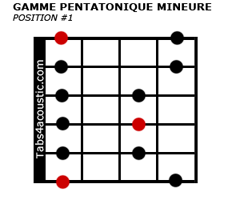
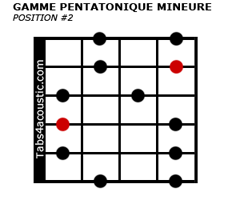
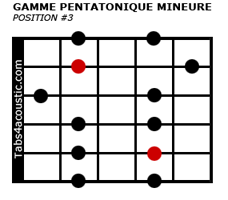
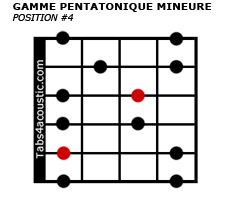
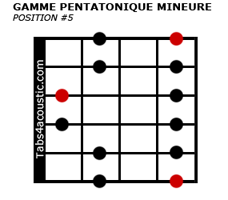
How to read the diagrams
- The red dots correspond to the keynote, i.e the main note on which your scale is based. This is what sets the atmosphere to the scale,
- All positions match with one another, i.e the notes located at the right end of each position are the same as those found at the left end of the next position (and after the 5th position we set out again on the first, which gives I - II - III - IV - V - I - II - III, etc),
- You must play with one finger per fret,
- Each position is played string by string, from top to bottom,
- It is complusory to work slowly in the beginning!
- Using a metronome is highly recommended (if you don't have one, go to our toolbox on tabs4acoustic.com on the right).
How to play a pentatonic scale - See an example
In order to get things clear, there's nothing like a practical example. So, let's consider (randomly) the pentatonic minor scale of “A”.
You will find below how you should play the first position: the tab notes correspond to the notes for the position, and the numbers on the top correspond to the fingers to use on each note (1 = index, 2 = middle, 3 = ring, 4 = little finger):
1 4 1 3 1 3 1 3 1 4 1 4-------------------------------5--8--------------- -------------------------5--8--------------------- -------------------5--7--------------------------- -------------5--7--------------------------------- -------5--7--------------------------------------- -5--8---------------------------------------------
and so on for the next positions:
2 4 1 4 1 4 1 3 2 4 2 4 -----------------------------------8--10---------- ----------------------------8--10----------------- ----------------------7--9------------------------ ---------------7--10------------------------------ --------7--10------------------------------------- -8--10-------------------------------------------- 1 3 1 3 1 3 1 4 1 4 1 3 ----------------------------------------10--12---- --------------------------------10--13------------ -------------------------9--12-------------------- -----------------10--12--------------------------- ---------10--12----------------------------------- -10--12------------------------------------------- 1 4 1 4 1 3 1 3 2 4 1 4 -----------------------------------------12--15--- ---------------------------------13--15----------- -------------------------12--14------------------- -----------------12--14--------------------------- ---------12--15----------------------------------- -12--15------------------------------------------- 2 4 1 4 1 4 1 4 2 4 2 4 -----------------------------------------15--17--- ---------------------------------15--17----------- -------------------------14--17------------------- -----------------14--17--------------------------- ---------15--17----------------------------------- -15--17-------------------------------------------
The fretboard
In a nutshell, here is what happens along the fretboard:

Location of the 1st position for each scale:
C : 8
C# : 9
D : 10
D# : 11
E : 0
F : 1
F# : 2
G : 3
G# : 4
A : 5
A# : 6
B : 7



